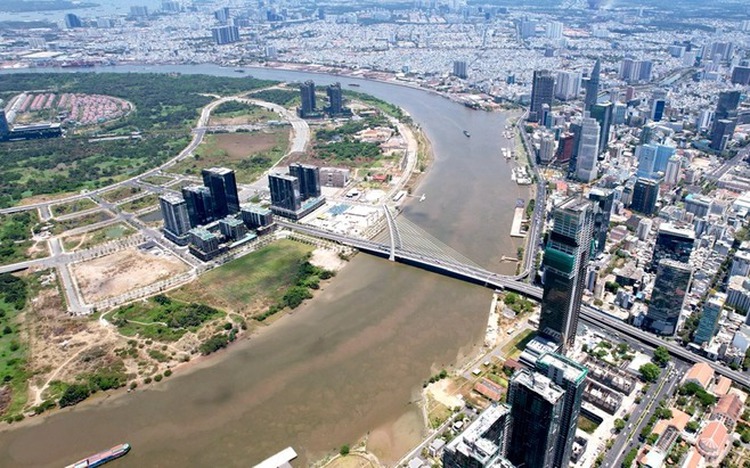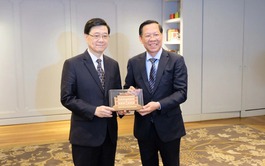
The areas on both banks of the Saigon River in Ho Chi Minh City – District 1 (R) and the Thu Thiem area in Thu Duc City (a district-level unit under Ho Chi Minh City) – are expected to form the core space of the city’s future international financial center. Photo: Ngoc Hien / Tuoi Tre
These priorities were highlighted during a seminar in the city on Tuesday, where participants stressed the importance of a development model tailored to Ho Chi Minh City’s unique context, rather than adopting existing international frameworks.
This discussion follows last year's approval by Vietnam’s Politburo for a comprehensive international financial hub in Ho Chi Minh City and a regional financial center in Da Nang.
The National Assembly is anticipated to review these proposals in its upcoming ninth session in May.
Determining a location
During the seminar, Nguyen Van Dung, deputy chairman of the Ho Chi Minh City People’s Committee, asserted that establishing clear boundaries is essential for the effective operation and competitiveness of the future international center.
This step is crucial for attracting strategic investors and fostering a robust financial ecosystem to support sustainable national growth.
Dinh Khac Huy, deputy director of the Department of Finance, acknowledged the complexity of determining the center's location and identified two main options.
The first option includes the Thu Thiem area in Thu Duc City (a district-level unit of Ho Chi Minh City) and part of District 1, covering a total of 687 hectares.
At its core is a 92-hectare zone in Thu Thiem, envisioned as a hub for financial institutions, regulatory bodies, and dispute resolution centers.
While this approach offers substantial long-term potential, its large scale may pose short-term implementation challenges.
The second option reduces the scope to 340 hectares, roughly the size of Singapore’s financial district, and focuses on concentrated early-stage investment.
Public and expert consultations indicate greater support for the larger plan, which aligns better with international trends and allows for future expansion.
Huy noted that Thu Thiem offers an advantage with its availability of land, ideal for developing both physical and digital infrastructure, while District 1 serves as the city’s financial core, housing major banks and high-end office buildings.
“Combining both areas would ensure continuity of financial activities throughout the development process," he added.
Tran Thanh Tan, vice-chairman of Dragon Capital, likened the need for defined space to create a 'marketplace' where financial players and support services can converge.
Assoc. Prof. Dr. Hoang Cong Gia Khanh, rector of the University of Economics and Law, emphasized that an international financial center should prioritize innovation and human resources alongside capital.
He warned that overly rigid boundaries could hinder progress and proposed an open model positioning Ho Chi Minh City as a hub for data, technology, and talent across sectors.
“We should create a space where financial innovation – especially from small- and medium-sized enterprises – can thrive,” Khanh stated.
Echoing this viewpoint, Mohammad Yousuf Al Najjar, senior vice-president of development and projects at the Dubai International Financial Center, presented two main approaches to developing an international financial center: treating the entire municipality as a hub, as in London, or designating a specific jurisdiction or district for development, as in Dubai.
He also stressed the importance of planning surrounding infrastructure, including housing, healthcare, and schools, to support the center’s growth.
Need for elite professionals
Dr. Truong Minh Huy Vu, director of the Ho Chi Minh City Institute for Development Studies, urged the establishment of a long-term human resource strategy to ensure the center’s success.
He emphasized that a competitive financial center relies on a workforce skilled in finance, banking, blockchain, artificial intelligence, and risk management.
“High-quality human resources will provide professional financial services that meet international standards, enhancing the center’s appeal,” Vu said.
Khanh added that developing such talent requires professionals with not only financial expertise but also interdisciplinary skills, adaptability to new technologies, and openness to international collaboration.
He proposed a three-tiered approach to talent development: top-level management and policy leaders, mid-level professionals, and students currently in training.
To support this, he recommended establishing an 'education sandbox,' similar to regulatory sandboxes in technology and finance.
“An education sandbox would allow for innovative training methods that can quickly adapt to market and technological needs, breaking free from rigid university and postgraduate education frameworks,” he noted.



Max: 1500 characters
There are no comments yet. Be the first to comment.